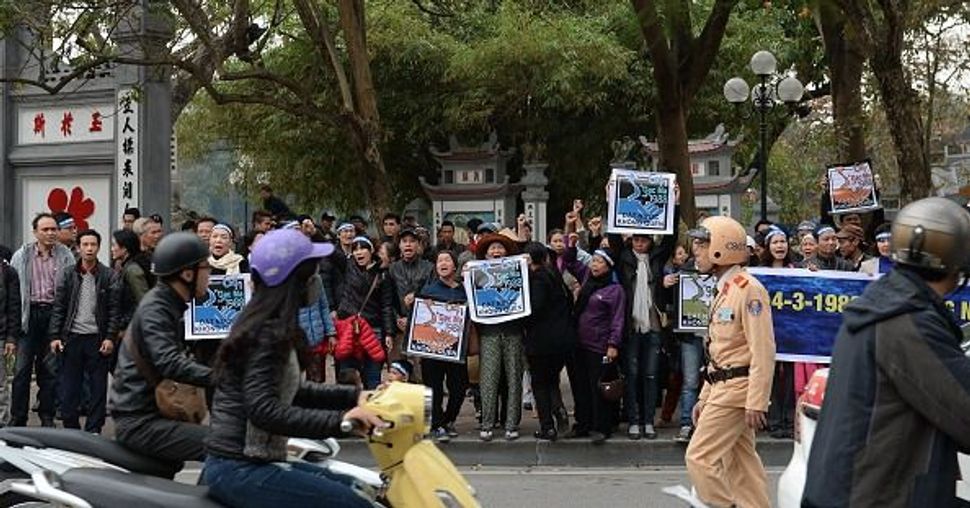Vietnam Looks to Defend South China Sea Claims with Israeli Weapons, Analysts Say

Activists chant anti-China slogans during a rally in Hanoi on March 14, 2016, to mark the anniversary of a 1988 battle in the Spratly Islands, a rare act of protest over an issue that has come to dog relations between Hanoi and Beijing. In 1988 China launched an attack on Gac Ma Island — one of the larger Spratly Islands which was formerly under Vietnamese military control — killing 64 Vietnamese soldiers in the last violent conflict between the two nations. / AFP / HOANG DINH NAM (Photo credit should read HOANG DINH NAM/AFP/Getty Images) Image by Getty
Vietnam has secretly fortified several of the islands it claims in the disputed South China Sea region with new mobile rocket launchers purchased from Israel, according to Western officials.
Foreign officials and military analysts believe the launchers form part of Vietnam’s Israeli state-of-art EXTRA rocket artillery system.
The launchers have been hidden from aerial surveillance and they have yet to be armed, but could be made operational with rocket artillery rounds within two or three days, according to the three sources. There is no sign the launchers have been recently test fired or moved.
Vietnam’s Foreign Ministry said the information was “inaccurate,” without elaborating.
EXTRA rounds are highly accurate up to a range of 150 km (93 miles), with different 150 kg (330 lb) warheads that can carry high explosives or bomblets to attack multiple targets simultaneously. Operated with targeting drones, they could strike both ships and land targets.
This is not the first time that Israeli weapons have shown up in conflict regions. In 2015, Israel’s arms sales were accused of fueling the civil war in South Sudan in a United Nations report, along with a questionable $1.6 billion in arms sales in 2012 to Azerbaijan, an authoritarian country in a tense conflict with neighboring Armenia.
While Vietnam has larger and longer range Russian coastal defense missiles, the EXTRA is considered highly mobile and effective against amphibious landings. It uses compact radars, so does not require a large operational footprint – also suitable for deployment on islets and reefs.
“When Vietnam acquired the EXTRA system, it was always thought that it would be deployed on the Spratlys…it is the perfect weapon for that,” said Siemon Wezeman, a senior arms researcher at the Stockholm International Peace Research Institute (SIPRI).
Deputy Defence Minister, Senior Lieutenant-General Nguyen Chi Vinh, told Reuters in Singapore in June that Hanoi had no such launchers or weapons ready in the Spratlys but reserved the right to take any such measures.
“It is within our legitimate right to self-defense to move any of our weapons to any area at any time within our sovereign territory,” he said.
The move is designed to counter China’s build-up on its seven reclaimed islands in the Spratlys archipelago. Vietnam’s military strategists fear the building runways, radars and other military installations on those holdings have left Vietnam’s southern and island defenses increasingly vulnerable.
Hanoi wanted to have the launchers in place as it expected tensions to rise in the wake of the landmark international court ruling against China in an arbitration case brought by the Philippines, foreign envoys said.
The ruling last month, stridently rejected by Beijing, found no legal basis to China’s sweeping historic claims to much of the South China Sea.
Vietnam, China and Taiwan claim all of the Spratlys while the Philippines, Malaysia and Brunei claim some of the area.
In recent years, Vietnam has significantly improved its naval capabilities as part of a broader military modernization, including buying six advanced Kilo submarines from Russia.—With Reuters
Contact Drew Gerber at [email protected] or on Twitter, @dagerber














